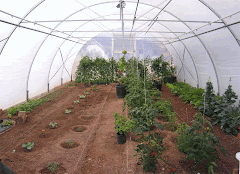
Allan Wright
Level: Basic
A disaster has occurred in your home, in your neighbourhood, in your city or your state. Being prepared for a disaster, before it happens, will help you and your family through the danger when it does occur.Evacuation:1.An Immediate risk to you and your Family: If you smell gas, smoke or see fire in your home, evacuate everybody immediately. Do not call for help from inside your home or go back to retrieve an item. In an emergency of this type, only the lives of your family are important. , Call 9-1-1 and report the emergency only from a safe location.2. Official General evacuation orders: If local officials issue general evacuation orders, immediately prepare to leave your house.· Wear sturdy shoes, long-sleeve shirts and pants.· Bring your Go-bag.· If you have a pet, make sure it is wearing a collar, use a pet carrier labeled with your name and the pet's name. Bring your pet's Go-bag.· Lock your home and shut off the water and electricity, but leave gas on unless instructed otherwise.· Leave a note and tell a neighbor where you are going.· Use the evacuation routes and methods specified in the evacuation order.· Carpool with neighbors whenever possible.· Once you arrive at a safe location, call your out-of-area emergency contact. This is a person that you know and have previously designated as your emergency contact person. All family members should call this person as soon as they in a safe location.Disaster Shelters:Immediately following a large disaster, suitable shelter sites will be selected from a list based on areas of need and estimated numbers of evacuees. Because each site must be inspected prior to being opened, it is not possible to say, which sites will actually be opened then a disaster does strikes .As soon as disaster sites have been designated, their locations will be announced by your local news media. If you do not have an alternative, evacuate to a designated emergency shelter.· Tell your out-of-town-contact where you are going.· Take your Emergency Kit (First Aid kit and Go Bag) with you to the shelter.· Initially, emergency shelters may not be able to provide basic supplies and materials. Consider bringing extra items (e.g. blanket, pillow, air mattress, towel, washcloth, diapers, food and supplies for infants.)·Provide for your pet: Only service animals are allowed in "human" shelters. If you cannot make other plans for your pets, Animal Care staff will be available at "human" shelters to help with pet sheltering needs.Electrical Power Failure: Power cuts can occur due to blackouts, extreme weather conditions, or can accompany other disasters such as earthquakes or terrorism. If there is no power in your neighborhood:· Turn off and unplug appliances and computers. Leave one light on to indicate when power has been restored.· Avoid using regular wax candles; they are fire hazards.· Do not use a gas stove for heating or operate generators indoors (including the garage.) Both can cause carbon monoxide poisoning· If traffic signals are not working, treat them like a stop sign.Earthquake:If you are indoors when shaking starts:· Get on the floor, cover your head and hold on. If you are not near a strong table or desk, drop to the floor against an interior wall or doorway and cover your head and neck with your arms.· Avoid being under or near windows, hanging objects, mirrors, tall furniture, large appliances and cabinets filled with heavy objects.· Do not try to exit the building during strong shaking.· If you are downtown, it is safer to remain inside a building after an earthquake unless there is a fire or gas leak. Remember that there are no open areas in downtown San Francisco far enough from glass or falling debris to be considered safe. It may be the same in your town.· Broken glass from high-rise buildings can travel great distances when caught by the wind.· If you are in bed, stay there and cover your head with a pillow.· Do not use elevators during or after a quake.· If you are in a wheelchair, lock the wheels and cover your head.If you are outdoors when shaking starts:· Move to a clear and open area if you can safely walk. Avoid power lines, buildings and trees.· If you're driving, pull to the side of the road and stop. Do not stop under an overhead hazard.· If you are on the beach, move to higher ground as soon as possible. An earthquake can cause a tsunami.Once the earthquake shaking stops:· Check those around you for injuries and provide first aid to the injured. Do not move seriously injured persons unless they are in immediate danger.· Check around you for dangerous conditions, such as fires, downed power lines and structure damage, before you move.· If you have fire extinguishers and are trained to use them, put out small fires immediately.· Check your phones to be sure they have not shaken off the hook and are tying up a line.· Turn off the gas supply only if you smell gas.· Inspect your home for damage.If you are trapped in debris and can not free yourself:· Move as little as possible so that you don't kick up more dust. Cover your nose and mouth with a handkerchief or piece of clothing.· Tap on a pipe or wall so that rescuers can hear where you are. Use a whistle if one is available. Shout only as a last resort.Severe Storm / FloodingSevere storms can cause landslides, flooding, uprooted trees, and downed utility lines. Be aware of these potential dangers in and around your neighborhood.· Tune to local Radio/TV channels for emergency information and instructions.· If you are asked to leave your property, shut off electric circuits. If advised by your local utility, shut off gas service as well.· If water has entered your garage or basement, do not walk through it - it may contain hazardous materials.· Never try to drive over a flooded road. This one mistake is the major cause of death during and after severe flooding.· If your car stalls, abandon it immediately. Attempting to move a stalled vehicle in flood conditions can be fatal.· Do not walk through moving water. Unexpected water depth and current can carry you away. If you must walk in water, walk where the water is not moving and use a stick to check the ground in front of you.· Stay well clear of downed power lines.· Do not allow children to play around fast moving water, storm drains or flooded areas.I hope that this information will help you and your family through any emergency situation that you may encounter.Remember, and I cannot stress this enough, nothing can help you and your family through a disaster as much as being prepared before it happens. Mr. Wright has been well recognized in the field of wholesale and retail products for over 24 years. He is now the V.P. and Project ...Article Word Count: 1143Allan WrightFirst Aid Kit Productshttp://www.firstaidkitproducts.comArticle Source: http://EzineArticles.com/?expert=Allan_WrightAllan Wright - EzineArticles ExpertAuthor







 I try to grow most of my herbs/spices for our yearly seasonings needs. It is amazing how much of this stuff you can fit in a small space. We have the following planted in our cullinary herb bed:
I try to grow most of my herbs/spices for our yearly seasonings needs. It is amazing how much of this stuff you can fit in a small space. We have the following planted in our cullinary herb bed:














